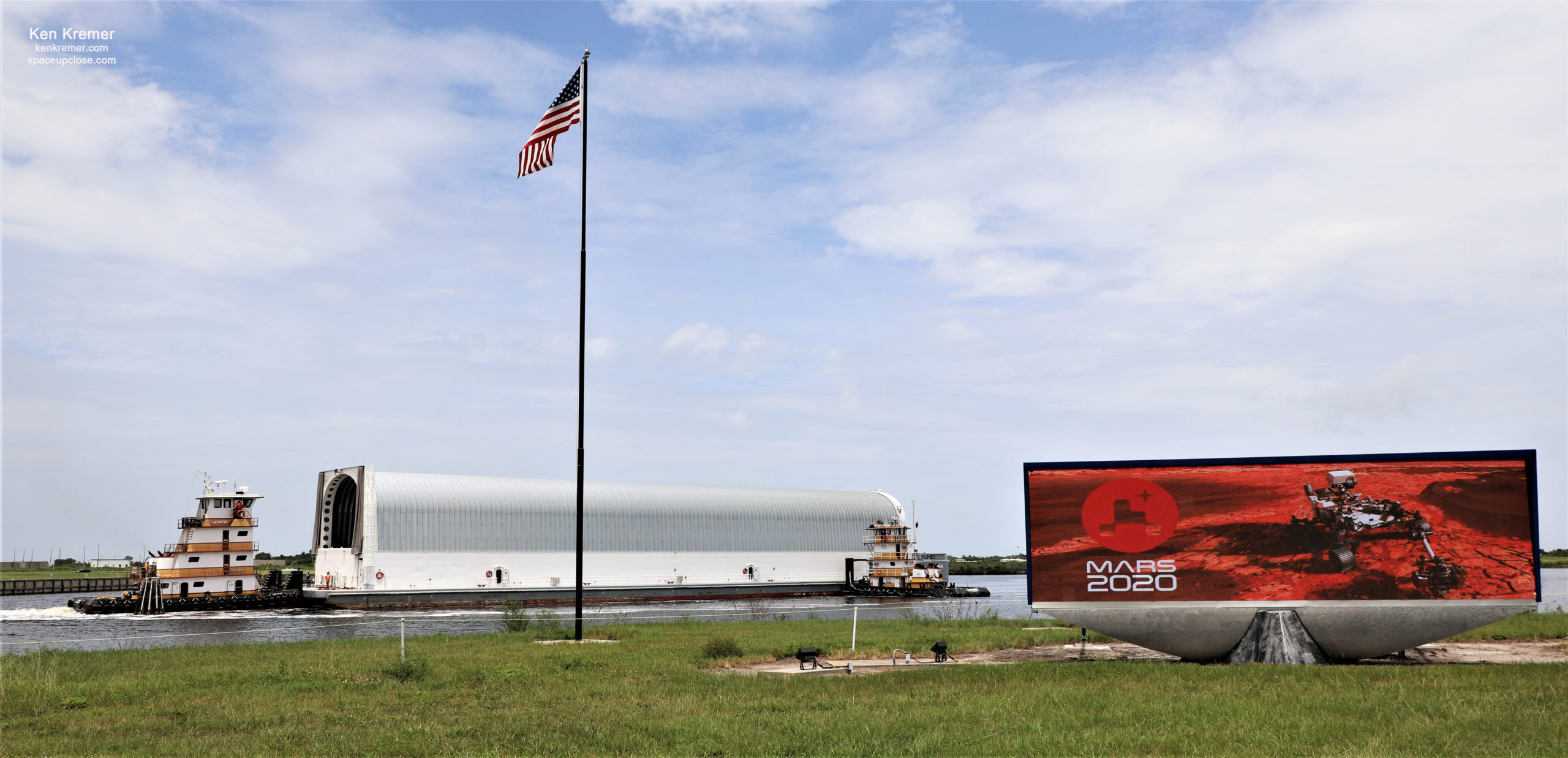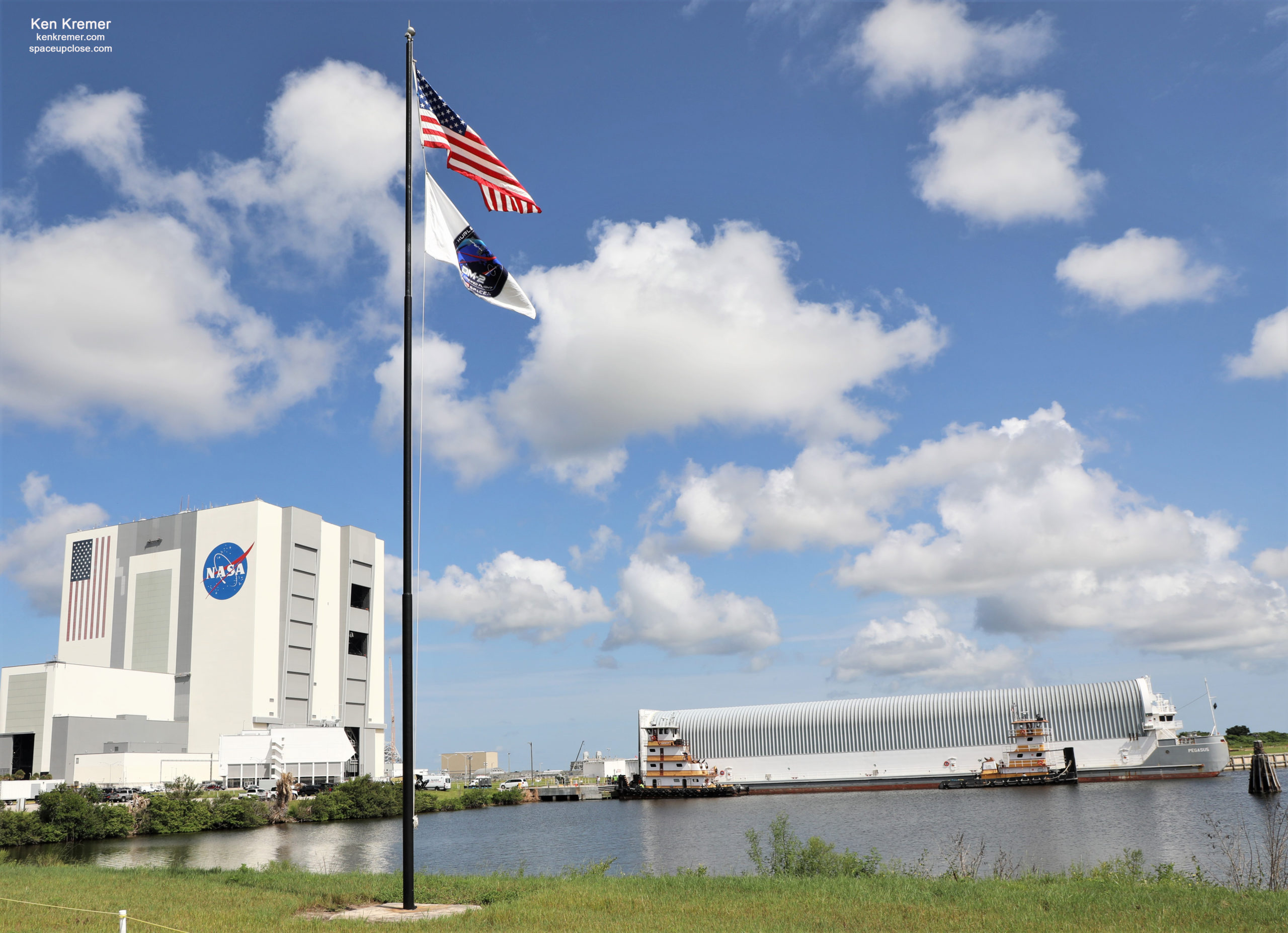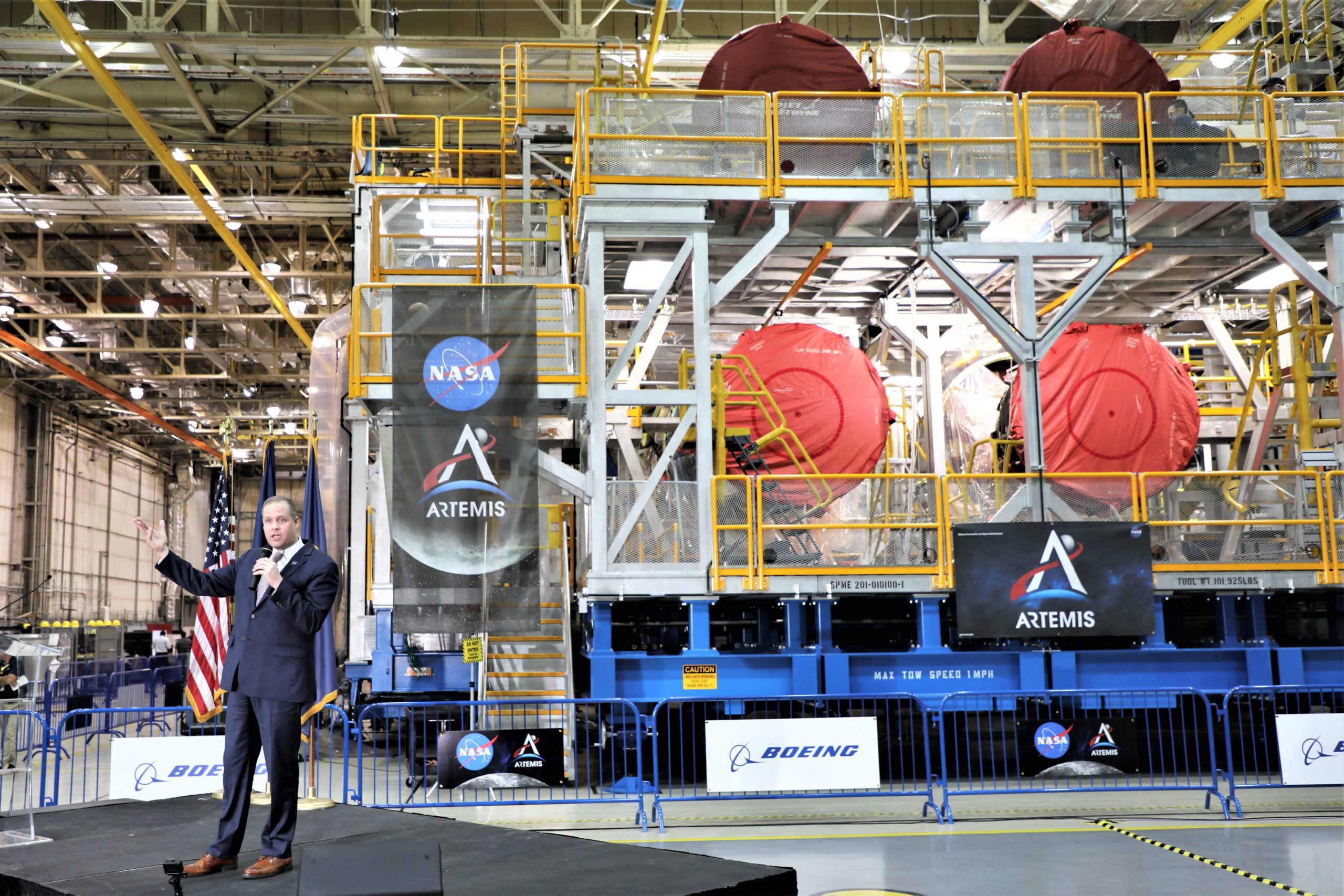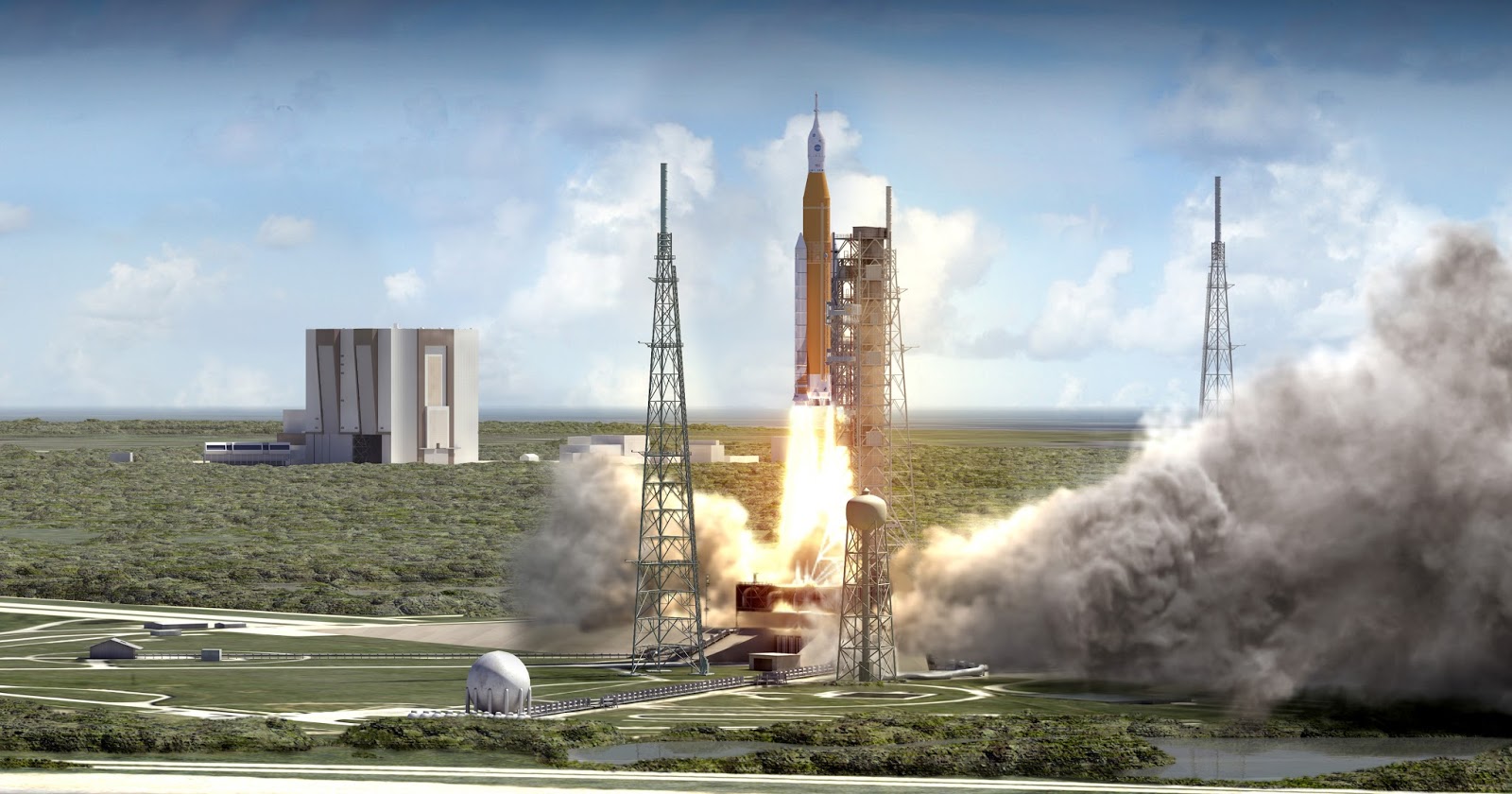
For SpaceUpClose.com & RocketSTEM
KENNEDY SPACE CENTER, FL – As NASA was in the final stages of launching the historic Mars 2020 Perseverance rover to the Red Planet and preparing for the historic splashdown return of two NASA astronauts from the first piloted Crew Dragon test flight to the Space Station, a key connecting component for the maiden test flight of the mammoth Space Launch System (SLS) Moon rocket for NASA’s Artemis 1 launch that will eventually humans to deep space and Mars arrived at the Kennedy Space Center (KSC) aboard the agency’s Pegasus Barge July 29.
The launch vehicle stage adapter (LVSA) that connects the core stage of NASA’s Space Launch System (SLS) rocket to the upper stage, called the Interim Cryogenic Propulsion Stage, arrived at lunchtime Wednesday, July 29 at Kennedy’s Launch Complex 39 turn basin wharf under sunny skies with Mars Perseverance poised for liftoff nearby at pad 41 on Cape Canaveral Air For Station.
“The launch vehicle stage adapter (LVSA) is the second to last piece of hardware for the Artemis I test flight around the Moon to arrive at Kennedy,” NASA Administrator Jim Bridenstine said at media briefing on July 29 as the LVAS arrived on Pegasus at the agency’s Kennedy Space Center in Florida.

The LVAS arrived at KSC’s turn basin wharf after traveling from NASA’s Marshall Space Flight Center in Huntsville, Alabama, to Florida towed by the tugboats American and Termite on the agency’s upgraded Pegasus barge.
Enjoy our Space UpClose gallery of LVAS/Pegasus arrival at KSC photos.

The 310-foot-long Pegasus vessel has been modified to transport the largest rocket stage in the world: namely the 212 foot long SLS core stage.

The SLS core stage is currently undergoing preparations at NASA’s Stennis Space Center in Mississippi for the critical ‘Green Run’ full duration hot fire test.
The SLS core stage is also transported by Pegasus
“NASA is now targeting October for the Green Run test,” Bridenstine told Space UpClose.
“Thereafter the SLS core stage will be transported to Kennedy.”

The cone-shaped LVAS connector also helps protect the RL10 engine housed in the Interim Cryogenic Propulsion Stage upper stage.
Technicians offloaded the LVSA and transported it to the Vehicle Assembly Building (VAB overnight where it will be stored until it is needed for stacking on the rocket.

“The launch vehicle stage adapter arriving to Kennedy is significant because we have almost all of the pieces of the rocket here as we get closer to launch,” said Allison Mjoen, operations project engineer with the Exploration Ground Systems program, in a statement.
“We have moved from planning into implementation, and soon the rocket will begin taking shape with stacking operations.”

NASA’s goal under Project Artemis is to land the first woman and next man on the lunar south pole surface by 2024 during the Artemis 3 mission when a crew of astronauts will launch in the Orion Crew Capsule atop the mammoth Space Launch System rocket – currently under development by NASA.
The SLS rocket and Orion Crew Capsule have been under development for a decade
Artemis 1 is the first flight in the Artemis program and involves an uncrewed multi-week test flight of Orion to the moon and back – launching late 2021.
The prior SLS components to arrive were the 10 segments of the twin Solid Rocket Boosters (SRBs) on June 10.


See our earlier article and photos.
The powerful solid rocket booster (SRB) segments for NASA’s inaugural SLS rocket liftoff on the Artemis 1 Moon mission arrived by train June 10 at KSC – thereby completing a 10 day cross country rail journey from their Northrop Grumman manufacturing facility in Promontory, Utah.

The twin SRB boosters will be stacked on the Mobile Launcher and eventually be attached to the SLS core stage
The ICPS provides the power necessary to break free of Earth’s gravity and depart Earth’s orbit and send the Orion crewed deep space spacecraft on its journey to the Moon.
The ICPS (as well as the Atlas V) is built by United Launch Alliance (ULA) and previously arrived at KSC. Read our earlier articles.
The core stage – made up of the forward skirt, liquid oxygen tank, liquid hydrogen tank, and the engine section containing the rocket’s four RS-25 engines – is the final piece of the rocket that will be delivered to Kennedy ahead of the Artemis I launch.
SLS is the most powerful rocket ever built.
The SLS core stage was built at NASA’s Michoud Assembly Facility in New Orleans and is the largest rocket stage the agency has built since the Saturn V that sent Apollo astronauts to the Moon.

The SLS core stage is currently in the test stand at NASA’s Stennis Space Center near Bay St. Louis, Mississippi where it is being readied for the critical Green Run full duration hot fire test later this year.
Thereafter it will be transported to Kennedy by the Pegasus barge for integration with the SRB’s and Orion.
SLS and Orion will launch off Launch Complex-39B at NASA’s Kennedy Space Center which has been extensively upgraded to support the new Heavy Lift rocket.

Watch my Aug 3 interview at ‘Stay Curious’ show American Space Museum about successful Mars Perseverance launch, successful splashdown SpaceX Crew Dragon on Demo-2 1st commercial mission , Artemis Moon mission and more:
https://www.facebook.com/SpaceWalkOfFame/videos/594560917928307/
Watch Ken’s continuing reports about Artemis, Commercial Crew, Mars and more onsite for live reporting of upcoming and recent SpaceX and ULA launches including Starlink, Solar Orbiter, In-Flight Abort, Mars 2020 and more at the Kennedy Space Center and Cape Canaveral Air Force Station.
Stay tuned here for Ken’s continuing Earth and Planetary science and human spaceflight news: www.kenkremer.com –www.spaceupclose.com – twitter @ken_kremer – email: ken at kenkremer.com
Dr. Kremer is a research scientist and journalist based in the KSC area, active in outreach and interviewed regularly on TV and radio about space topics.
………….
Ken’s photos are for sale and he is available for lectures and outreach events

Artists concept of SLS launch from KSC. Credit: NASA
x




